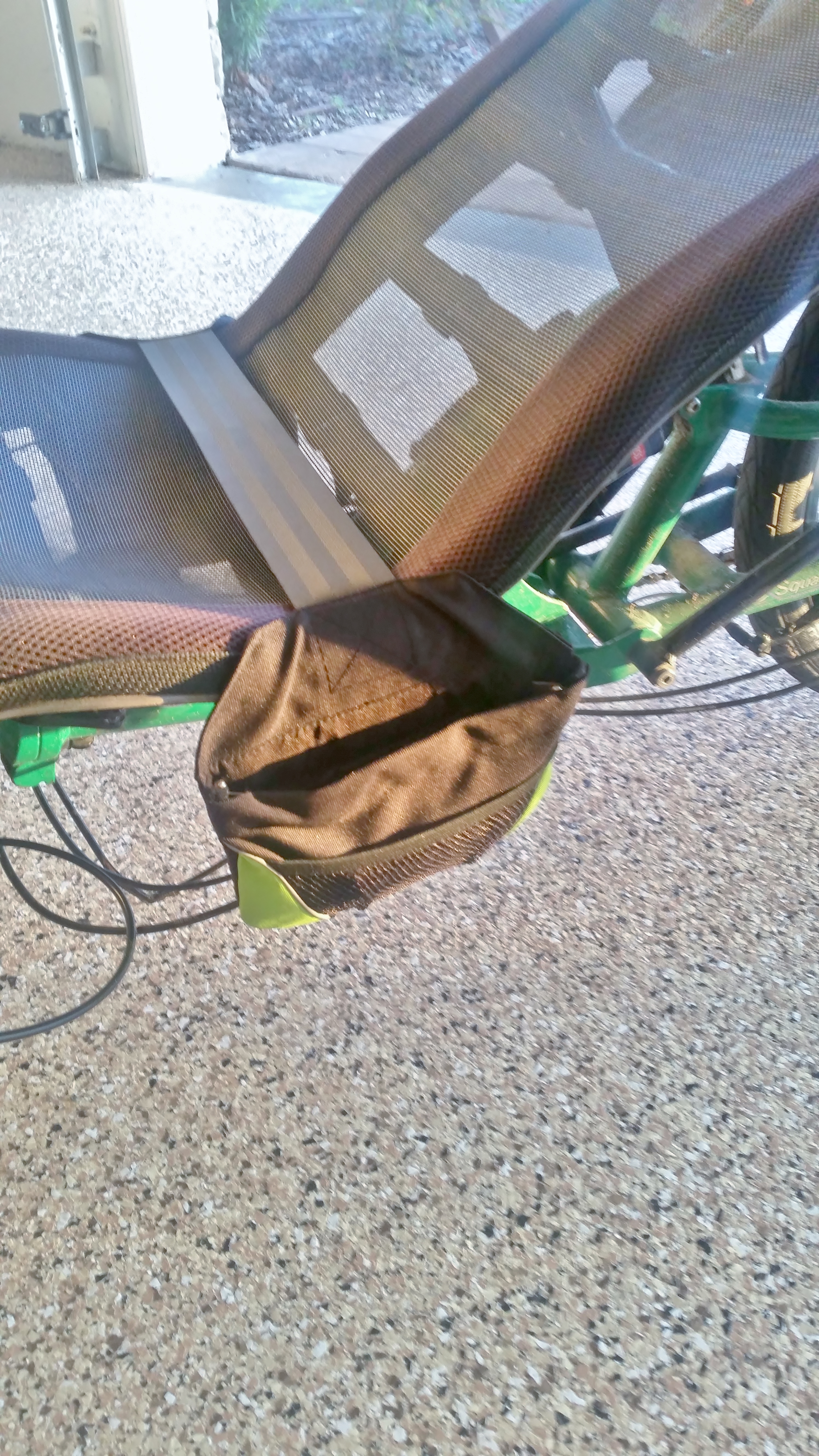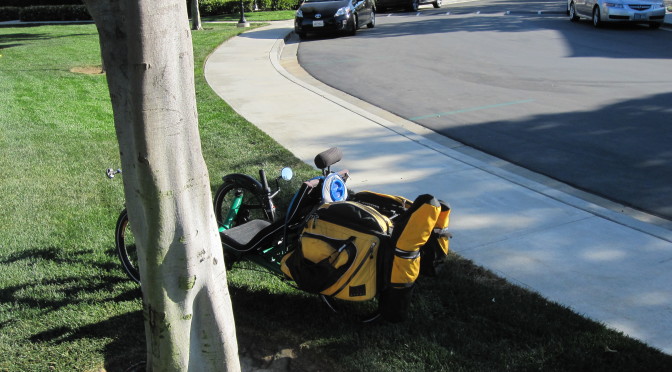In Part I and Part II of this 4 part series, I talked about the trike I ride and what makes it a safe and efficient vehicle for long tours,
Going solo on a long rides means I carry everything I need along with me on the trike. There are two problems with carrying stuff – it takes up space and it is heavy. Space and weight are both in pretty limited supply on a trike, so it is necessary to get a little creative with the packing. In this segment I’ll discuss the how I approach the problem of carrying stuff on the trike.
Racks
First off, the trike sports a rack above the rear wheel that extends from the seat back to just behind the rear wheel. The rack is used to hold stuff. Stuff is piled on top of it, and stuff is hung off the sides of it. The rack is made out of same beefy aluminum tubing as the rest of trike so it can hold a lot of weight. The rack also sits on top of the suspension, just like the seat. So all the stuff attached to the rack gets to ride in the same fully suspended comfort as the rider!
Pannier Bags
I use the rack to hold up panniers. Panniers are basically saddle bags that are filled up with stuff and then hung on the sides of the rack. Panniers are a topic that cycle tourists love to discuss, debate and argue about. How big? How heavy? Water proof or not? One big compartment or several smaller ones? The choices are endless and the decisions affect the way your stuff is stored, accessed and used. That ends up having a big impact on the flow of a tour.

The panniers that I ended up choosing are the Arkel RT-60’s. I chose them for a number of reasons:
- Really Big. The Arkel panniers will hold 3650 cubic inches of stuff
- Recumbent specific. Recumbent bikes and trikes sit lower to the ground than a traditional bike. Panniers that work on an upright bike, particularly large panniers, might be too tall to fit on a recumbent. Recumbent bikes, however, do allow for a wider pannier than will work on an upright bike. The Arkel panniers are not too tall, but are quite wide, and they fit perfectly on my trike.
- Not waterproof. Waterproof bags sound like a good idea. When it rains, stuff will stay dry. But waterproof bags not only keep water out, they keep water in. Any water inside evaporates when it gets sunny, but the vapor can’t get out, so everything else in the bag gets damp. And then it starts to grow mold. Better to have bags that can dry out. The Arkel bags have rain covers that slip over the bags when it starts to rain, then removed when the sun comes out.
- A few pockets, but not too many. I have a difficult time organizing my stuff in one big compartment. I prefer to separate different kinds of stuff into different parts of the bags. But the pockets must be big enough, and hold enough stuff, to be useful. Lots and lots of little tiny compartments don’t help much. The Arkel bags each have 1 big main compartment, 1 medium secondary compartment, a thin, flat compartment (great for maps and papers), a top compartment (easy to get to when the bike is loaded), and an outside mesh compartment. Each bag also has an additional, removable, tube shaped compartment that Velcros onto the back of the bag. Its perfect for holding long, tube shaped things, like tents and poles, sleeping pads, fuel canisters for the stove, towels, etc.
- Heavy duty. These bags are made of tough stuff, and zippers are big and beefy. I don’t think they will rip, tear or self destruct while I’m out on the road.

Keeping Small Stuff Handy
Sometimes on a long ride I need to reach things that I’ve packed up. My camera, sun screen, my wallet, etc. When I want to get to these things, it is a bit of a pain to stop the bike, climb off and go open up the panniers to find what I am seeking. Instead, I can keep things in two small packs that are conveniently right next to me on the trike’s seat. These little packs are made by Smokey Mountain Saddlebags, and are just the perfect size for keeping small stuff handy

Water
It’s really important for a cyclists to stay hydrated during a long ride. Getting dehydrated and overheating is painful and dangerous. A basic guideline is to drink about 20 ounces of water for every hour that you ride. Depending on personal physiology or warm temperatures, you may need to drink more. And once I get where I am going, I may need to have water on hand to cook with or make into tea.
I keep the Camelback Unbottle on the back of my seat. It holds up to 100 oz of water. It’s basically a big plastic bag with a drinking tube than runs over my shoulder. It let’s me drink easily, when I want.
Next Up
This segment describes that racks and bags I used to carry stuff around while on tour. The panniers and the rack give me a ton of space to carry what I want. So, what kind of stuff do I carry – read Part IV to find out…


